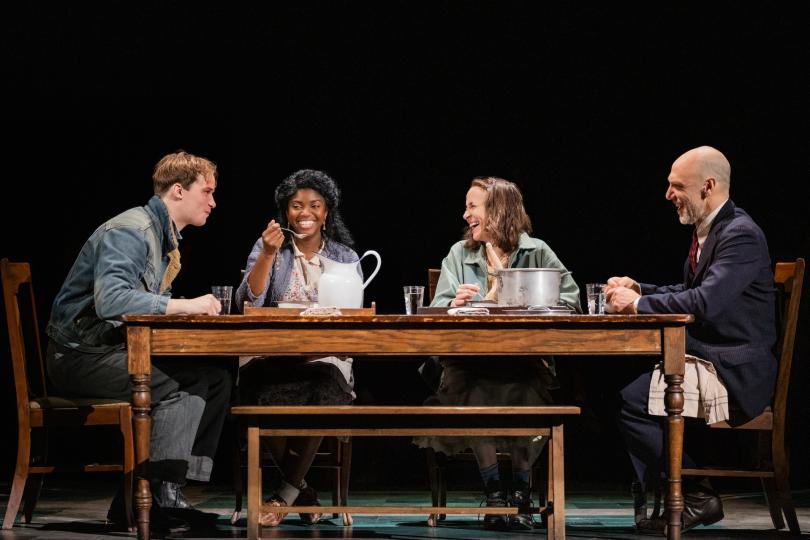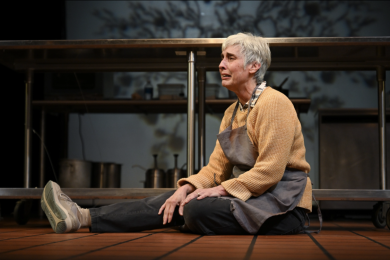Sad News and Great Music from the North Country

Bob Dylan’s lyrics earned him a Nobel Prize in Literature, not to mention influence on the whole generation. But he was never known for his singing voice, a rough sound that fit well with songs of rebellion but was never a good match for his songs expressing love or longing. In “Girl from the North Country,” the Tony Award-winning Broadway musical now being performed at The Orpheum, Dylan’s powerful lyrics are given voice by wonderful singers, and are offered in support of Conor McPherson’s interlocked series of melancholy tales.
The work takes place in Duluth in 1934 (Dylan was born in that city in 1941), in a small boarding house run by Nick Lane (John Schiappa). Nick is deeply in debt, his wife, Elizabeth (Jennifer Blood), is mentally ill, his son, Gene (Ben Biggers) is unemployed, and his adopted daughter, Marianne (Sharaé Moultrie) is pregnant, with the father, she claims, being far away. Also in the boarding house are Mr. Burke (David Benoit), who lost his business in the Depression, his wife (Jill Van Velzer), and their mentally disabled son, Elias (Aidan Wharton); and a widow with whom Nick has been having an affair, Mrs. Neilsen (Carla Woods). Late at night they are joined by an itinerant Bible seller, Reverend Marlowe (Jeremy Webb), and a boxer, Joe Scott (Matt Manuel), just released from prison. Other characters include the community doctor, and the play’s narrator, Dr. Walker (Alan Ariano), and an elderly shoe mender with whom Nick has been trying to fix up Marianne, Mr. Perry (Jay Russell). Everyone seems to be carrying important secrets; some are revealed in the course of the performance, others are not. Nearly everyone is miserable.
While some of the stories intersect brilliantly, the plot is not a tight weave. There are a few characters that engage us only briefly before their story lines taper off. McPherson is trying to give us a snapshot of a motley collection of lost and down-on-their-luck citizens and transients. All of the stories are individually intriguing, but perhaps he’s trying to tell many at once. On the other hand, the play’s density gives the audience a lot to think about, reflections one will revisit for a long time after the show is over.
The play is also packed with social and political issues: from racism to sexual harassment to abortion to economic injustice. Prominently, Joe Scott served time for a crime of which he was falsely accused, and at the boarding house, he is again met with prejudice: he is given just a corner of the floor while the white man he is traveling with is given a room. And Marianne Lane is regularly reminded of how limited and grim her options are as an African American woman and someone about to be a single mother.
Regardless of its generous use of winter humor and the fun familiarity of the Duluth setting, “Girl” is a layered, serious play, with psychologically complex characters and deep dives into Minnesota social and political history (we are reminded of some of the most shameful moments in our shared past, including lynchings of three African-Americans in Duluth in 1920). Through McPherson’s writing and directing, the work has very much the feel of a dark-toned, richly ironic lyrical Irish play (with shades of J.M. Synge and perhaps of Brian Friel), where the characters seem always to feel the weight of history and loss.
The play’s genesis is interesting. McPherson reports “that Bob Dylan’s management team contacted him about writing a play featuring selections from their client’s vast, cherished catalog. When McPherson wrote a brief treatment, Bob Dylan responded to the writer: “You could do what you like.” McPherson wrote that he hears echoes of James Joyce in Dylan’s lyrics (in some literary circles, there is no higher compliment).
The strength of the production is clearly in the songs. A number of well-known Dylan pieces (e.g., “Like a Rolling Stone,” “Hurricane,” “All Along the Watchtower,” and “Forever Young”) are creatively rethought, while some less-well-known songs (e.g., “Tight Connection to My Heart (Has Anyone Seen My Love)”) are, in their present reinventions, revelations. All are beautifully arranged and sung (generally in slow ballad style), with excellent musical support (credit to Simon Hale for the arrangements and orchestrations, to Dean Sharenow for Music Coordination, and Marco Paguia as Music Director). The songs remind us of the wide range of music traditions on which Dylan’s work calls: folk and country and gospel and blues, just to sample a long list. In the Press Notes, McPherson notes that “a lot of the time, the songs actually have very little to do with what’s going on in the story, but they reveal something about the story that you didn’t know about. That’s how great a writer Dylan is.”
Overall, this is an important and thought-provoking evening of song and story, beautifully performed. It’s not to be missed.
Photo Credit: Evan Zimmerman




